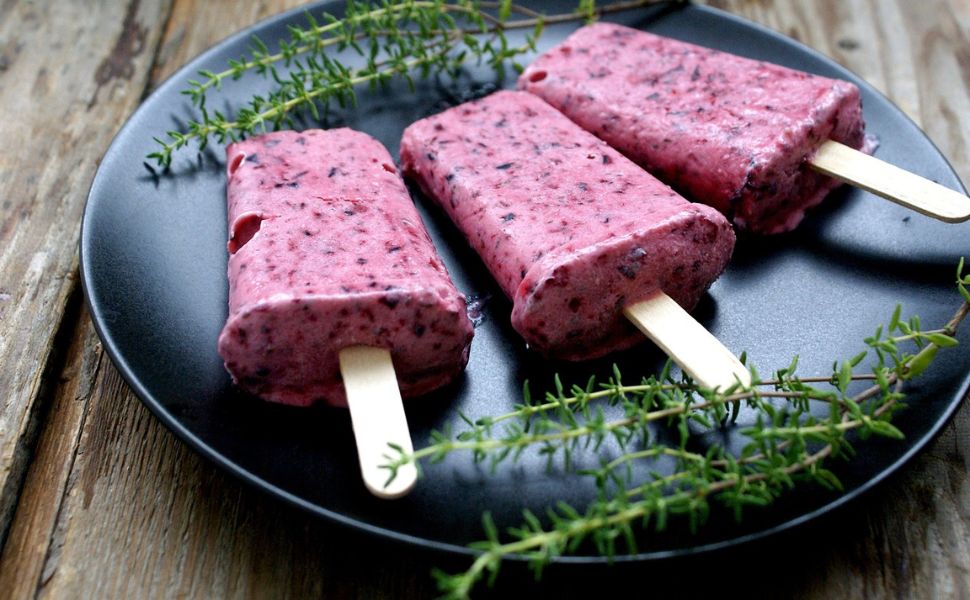Blueberry yogurt popsicles for toddlers are my go to recipe replacing any other sugary popsicles.
As the summer heat starts to soar, finding refreshing and healthy treats for your little ones becomes a top priority. Popsicles are a favorite among toddlers, but often store-bought versions can be loaded with added sugars and artificial ingredients. Luckily, there’s a simple and nutritious solution that will delight both parents and kids alike – homemade Blueberry Yogurt Popsicles! These frozen delights are not only a delicious summer treat but also packed with essential nutrients that support your child’s growth and development.
Blueberry yogurt popsicles are a delightful summer treat that toddlers will adore. The combination of antioxidant-rich blueberries and calcium-packed yogurt makes these popsicles not only delicious but also beneficial for your child’s growth and development. So, beat the heat with this simple and healthy recipe, and watch your toddlers relish every bit of these refreshing treats!
Table of Contents
- The Nutritional Benefits of Blueberry Yogurt Popsicles for toddlers:
- What you need to make blueberry frozen yogurt?
- Instructions to make yogurt popsicles for toddlers
- Variations – Yogurt and blueberries
- Safety Tips:
- Other healthy desserts for toddlers
- FAQs – Yogurt popsicles for toddler
- Can you freeze yogurt like a popsicle?
- What is the best yogurt for popsicles?
- When can toddlers eat popsicles?
- Is frozen yogurt really healthier than ice cream?

The Nutritional Benefits of Blueberry Yogurt Popsicles for toddlers:
- Antioxidant-Rich Blueberries: Blueberries are tiny powerhouses of antioxidants that help protect the body from harmful free radicals. They contain vitamins C and K, as well as anthocyanins, which contribute to the fruit’s vibrant color and numerous health benefits.
- Calcium from Yogurt: Yogurt is an excellent source of calcium, essential for building strong bones and teeth in growing toddlers. Additionally, yogurt provides probiotics, which promote a healthy gut and aid in digestion.
- Vitamin-Packed: Yogurt is rich in essential vitamins such as B12, riboflavin, and phosphorus, which play vital roles in maintaining overall health.
- Natural Sweetness: By using fresh blueberries and a touch of honey or maple syrup, you can keep the sweetness natural and avoid excessive added sugars found in store-bought popsicles.
What you need to make blueberry frozen yogurt?
Here are few simple ingredients that you need to make this natural and simple recipe:
- 1 cup fresh blueberries (frozen can also be used)
- 1 cup plain Greek yogurt (full-fat for toddlers). Homemade yogurt will be ideal.
- Popsicle molds and sticks

Instructions to make yogurt popsicles for toddlers
- In a blender or food processor, combine the blueberries and yogurt. Blend until you achieve a smooth, uniform mixture.
- Taste the mixture and make sure it is not sour. If sour, add a tbsp of maple syrup or honey to make it sweet.
- Pour the blueberry yogurt mixture into popsicle molds, leaving a little space at the top for expansion during freezing.
- Insert the popsicle sticks into each mold, ensuring they are positioned upright.
- Place the molds in the freezer and let them set for at least 4-6 hours or overnight.
- To remove the popsicles from the molds, run the outside of the mold under warm water for a few seconds to loosen the popsicles.
- Serve the delightful blueberry yogurt popsicles to your toddlers, and watch their eyes light up with joy!
Variations – Yogurt and blueberries
- For an extra nutrient boost, consider adding a tablespoon of chia seeds to the mixture before freezing. Chia seeds are an excellent source of omega-3 fatty acids and fiber.
- You can also try experimenting with other fruits like strawberries, raspberries, or mangoes to create different flavored popsicles.
- To make the yogurt popsicles for toddlers even more appealing, you can dip them in melted dark chocolate and sprinkle some crushed nuts on top before freezing.

Safety Tips:
- Always ensure that the popsicle sticks are inserted securely, and monitor your toddler while they enjoy their treat to prevent any choking hazards.
- If your child is too young for popsicles, you can serve the blueberry yogurt mixture as a smoothie or frozen in silicone teething molds.
Other healthy desserts for toddlers
FAQs – Yogurt popsicles for toddler
Can you freeze yogurt like a popsicle?
Yes, you can definitely freeze yogurt to make yogurt popsicles for toddlers! Freezing yogurt is a simple and delicious way to create a refreshing and healthy treat for both kids and adults. Yogurt popsicles are a great alternative to store-bought popsicles, as they allow you to control the ingredients and avoid added sugars and artificial additives.
Freezing yogurt to make popsicles is a fantastic way to enjoy a healthy and refreshing treat during hot weather. Whether you choose to keep it plain or add various flavors and toppings, yogurt popsicles are sure to be a hit with kids and adults alike. So, don’t hesitate to get creative in the kitchen and explore different combinations to create the perfect yogurt popsicles for toddlers to beat the heat!
What is the best yogurt for popsicles?
The best yogurt for making popsicles depends on your personal preferences and dietary needs. Here are some popular options to consider:
- Greek Yogurt: Greek yogurt is a thick and creamy option that works exceptionally well for popsicles. It has a higher protein content than regular yogurt, making it a filling and satisfying choice. The thick consistency also creates a smoother texture in the popsicles.
- Regular Yogurt: Regular yogurt, whether plain or flavored, can also be used for popsicles. It is generally thinner than Greek yogurt, but it freezes well and provides a lighter texture in the popsicles.
- Full-Fat Yogurt: Using full-fat yogurt can add a rich and creamy texture to the popsicles, making them more indulgent. Full-fat yogurt is a great option, especially for younger children who need the extra calories and nutrients for their growth and development.
- Low-Fat or Non-Fat Yogurt: If you’re looking for a lighter option with fewer calories, you can use low-fat or non-fat yogurt. While these varieties may result in a slightly icier texture, they are still delicious and healthier alternatives to store-bought popsicles.
- Plant-Based Yogurts: For those who follow a vegan or dairy-free diet, plant-based yogurts made from soy, almond, coconut, or oat can be used to make delicious vegan popsicles. Make sure to choose varieties with a consistency similar to traditional yogurt for the best results.
- Flavored vs. Plain Yogurt: The choice between flavored and plain yogurt comes down to personal taste and dietary preferences. If you use flavored yogurt, keep in mind that it might already contain added sugars. Adjust the sweetness of your popsicle recipe accordingly to avoid excess sugar intake.
- Low-Sugar or No-Sugar-Added Yogurt: Opting for low-sugar or no-sugar-added yogurt is a healthier choice, especially when making yogurt popsicles for toddlers. You can sweeten the popsicles naturally with fruits like berries, mashed bananas, or a touch of honey or maple syrup.
Remember that when making yogurt popsicles for toddlers, you can customize them by adding fresh fruits, nuts, seeds, or sweeteners to suit your taste. It’s also essential to choose a yogurt brand that you trust and enjoy, as the flavor and quality of the yogurt will greatly impact the taste of the popsicles.
When can toddlers eat popsicles?
Toddlers can eat popsicles once they are ready for solid foods and have developed the necessary eating and swallowing skills. Generally, this occurs around 12 months of age when they transition from a diet primarily consisting of breast milk or formula to more diverse foods.
Here are some guidelines to consider when introducing popsicles to toddlers:
1. Age Appropriateness: As mentioned, it’s best to wait until your child is around 12 months old before offering popsicles. At this age, they can handle solid foods, and their risk of choking is significantly reduced.
2. Textures and Consistency: When introducing popsicles, ensure that they are made from safe and smooth purees or liquids that are easy for your toddler to handle. Avoid large chunks or pieces that could pose a choking hazard.
3. Supervision: Always supervise your toddler while they are eating popsicles to prevent any choking incidents or potential accidents.
4. Ingredients: When making or choosing yogurt popsicles for toddlers, use natural and wholesome ingredients. Avoid popsicles with added sugars, artificial flavors, and excessive food additives.
5. Allergies: Be mindful of any food allergies your toddler may have. If you’re introducing new ingredients in the popsicles, it’s essential to watch for any allergic reactions.
6. Moderation: Popsicles can be a fun treat, but they should be offered in moderation as part of a balanced and nutritious diet. They should not replace regular meals or healthy snacks.
7. Consider Messiness: Toddlers may not eat popsicles as neatly as older kids or adults. Be prepared for potential messes and have wipes or a damp cloth handy.
8. Temperature Sensitivity: Cold popsicles might be too cold for some toddlers, especially those with sensitive teeth or mouths. If you notice any discomfort, consider letting the popsicle sit for a moment before offering it again.
9. Alternative Forms: If you’re concerned about popsicles being a choking hazard or too messy, you can also serve the same yogurt and fruit mixture in silicone teething molds or as a smoothie in a sippy cup.
By keeping these guidelines in mind and ensuring that the popsicles are age-appropriate and safe, you can introduce this delightful and refreshing treat to your toddler, adding a touch of joy and excitement to their eating experience.
Is frozen yogurt really healthier than ice cream?
The healthiness of frozen yogurt compared to ice cream depends on various factors, including the specific ingredients used, serving sizes, and individual dietary needs. Let’s explore the differences between frozen yogurt and ice cream to better understand their nutritional profiles.
Blueberry Frozen Yogurt:
- Probiotics: One of the significant advantages of frozen yogurt is that it often contains live probiotic cultures. These beneficial bacteria can support gut health and digestion.
- Lower Fat Content: Frozen yogurt typically has less fat than traditional ice cream. Some varieties use non-fat or low-fat yogurt, making it a lower-calorie option for those watching their fat intake.
- Calcium: Yogurt is a good source of calcium, which is essential for bone health.
- Added Sugars: While frozen yogurt might have less fat, it can still be high in added sugars. Some commercial frozen yogurt options can contain significant amounts of sugar to enhance the flavor.
Ice Cream:
- Creaminess: Ice cream tends to be creamier and richer in flavor due to its higher fat content. The higher fat content can also contribute to a smoother texture.
- Higher Fat Content: Ice cream typically contains a higher fat content, which can make it more calorie-dense. For those looking to limit their fat intake, this could be a consideration.
- Lower Sugar Content: Traditional ice cream tends to have lower sugar content compared to some frozen yogurt options. However, some premium ice creams can still have significant amounts of added sugars.
The Bottom Line:
When comparing frozen yogurt and ice cream, the healthier option depends on your individual dietary goals and preferences. If you prioritize probiotics and lower fat content, frozen yogurt may be a better choice. However, it’s essential to be cautious about the sugar content in some frozen yogurt varieties.
On the other hand, if you prefer the creamier texture and are not concerned about the fat content, premium ice cream in moderation can be a delicious treat.
Tips for Healthier Choices:
- Read Labels: Whether choosing frozen yogurt or ice cream, check the nutrition label to be aware of the fat, sugar, and calorie content. Look for options with lower added sugars and moderate fat content.
- Portion Control: Regardless of which frozen treat you choose, be mindful of portion sizes. Consuming excessive amounts of either can lead to unwanted calorie intake.
- Make Your Own: Consider making your frozen treats at home, using natural ingredients, and controlling the amount of added sugars. You can make healthier versions of both frozen yogurt and ice cream by using fresh fruits, natural sweeteners, and low-fat dairy options.
- Mix and Match: You don’t have to choose between the two. You can create a healthier dessert by combining small servings of frozen yogurt with fresh fruits or adding a sprinkle of nuts on top.
Ultimately, both frozen yogurt and ice cream can be enjoyed as treats in moderation. The key is to be mindful of the ingredients and portion sizes, so you can savor these frozen delights guilt-free.
Blueberry Yogurt Popsicles for Toddler
Blueberry yogurt popsicles are a delightful summer treat that toddlers will adore. The combination of antioxidant-rich blueberries and calcium-packed yogurt makes these popsicles not only delicious but also beneficial for your child's growth and development. So, beat the heat with this simple and healthy recipe, and watch your toddlers relish every bit of these refreshing treats!Ingredients
- 1 cup fresh blueberries frozen can also be used
- 1 cup plain Greek yogurt full-fat for toddlers. Homemade yogurt will be ideal.
- 4/6 Popsicle molds and sticks
Instructions
- In a blender or food processor, combine the blueberries and yogurt. Blend until you achieve a smooth, uniform mixture.
- Taste the mixture and make sure it is not sour. If sour, add a tbsp of maple syrup or honey to make it sweet.
- Pour the blueberry yogurt mixture into popsicle molds, leaving a little space at the top for expansion during freezing.
- Insert the popsicle sticks into each mold, ensuring they are positioned upright.
- Place the molds in the freezer and let them set for at least 4-6 hours or overnight.
- To remove the popsicles from the molds, run the outside of the mold under warm water for a few seconds to loosen the popsicles.
- Serve the delightful blueberry yogurt popsicles to your toddlers, and watch their eyes light up with joy!
Notes
Variations – Yogurt and blueberries
- For an extra nutrient boost, consider adding a tablespoon of chia seeds to the mixture before freezing. Chia seeds are an excellent source of omega-3 fatty acids and fiber.
- You can also try experimenting with other fruits like strawberries, raspberries, or mangoes to create different flavored popsicles.
- To make the yogurt popsicles for toddlers even more appealing, you can dip them in melted dark chocolate and sprinkle some crushed nuts on top before freezing.






1 thought on “#1 Easy and Healthy Blueberry Yogurt Popsicles for Toddlers”